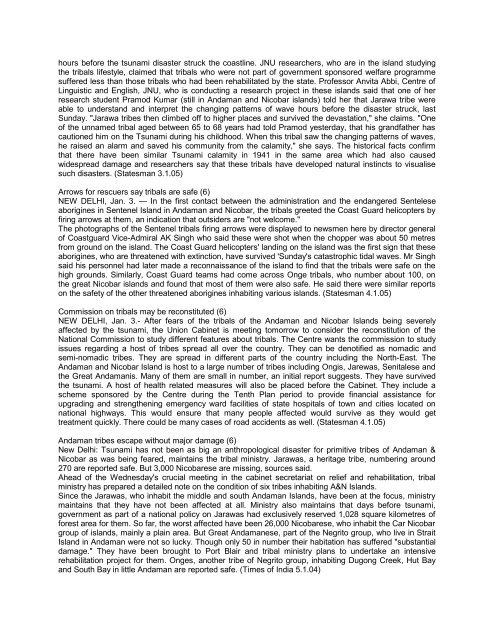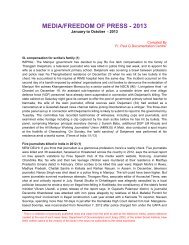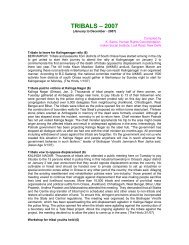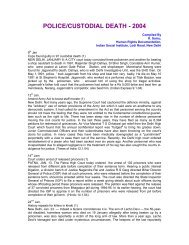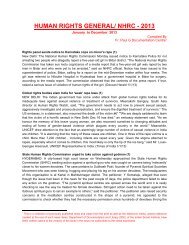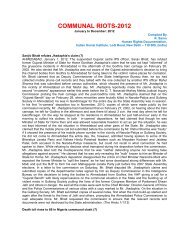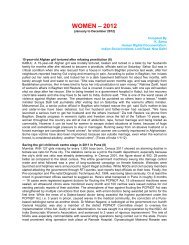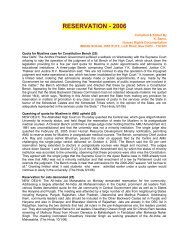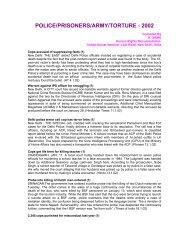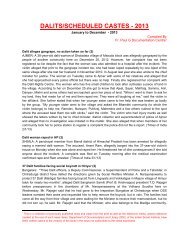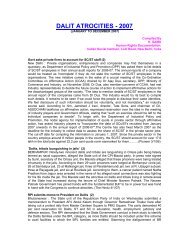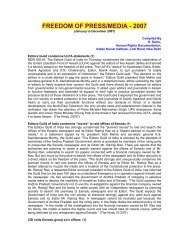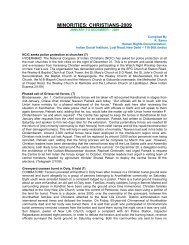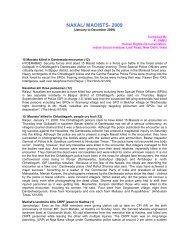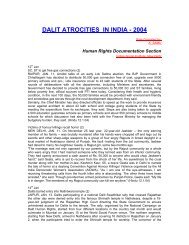Create successful ePaper yourself
Turn your PDF publications into a flip-book with our unique Google optimized e-Paper software.
hours before the tsunami disas ter struck the coastline. JNU researchers, who are in the island studying<br />
the tribals lifestyle, claimed that tribals who were not part of government sponsored welfare pro gramme<br />
suffered less than those tribals who had been rehabilitated by the state. Professor Anvita Abbi, Centre of<br />
Linguistic and English, JNU, who is conducting a research project in these islands said that one of her<br />
research student Pramod Kumar (still in Andaman and Nicobar islands) told her that Jarawa tribe were<br />
able to under stand and interpret the changing pat terns of wave hours before the disaster struck, last<br />
Sunday. "Jarawa tribes then climbed off to higher places and sur vived the devastation," she claims. "One<br />
of the unnamed tribal aged between 65 to 68 years had told Pramod yesterday, that his grandfather has<br />
cau tioned him on the Tsunami during his childhood. When this tribal saw the changing patterns of waves,<br />
he raised an alarm and saved his community from the calamity," she says. The historical facts confirm<br />
that there have been similar Tsunami calamity in 1941 in the same area which had also caused<br />
widespread damage and researchers say that these tribals have developed natural instincts to visualise<br />
such disasters. (Statesman 3.1.05)<br />
Arrows for rescuers say tribals are safe (6)<br />
NEW DELHI, Jan. 3. — In the first con tact between the administration and the endangered Sentelese<br />
aborigines in Sentenel Island in Andaman and Nicobar, the tribals greeted the Coast Guard helicopters by<br />
firing arrows at them, an indication that outsiders are "not welcome."<br />
The photographs of the Sentenel trib als firing arrows were displayed to news men here by director general<br />
of Coastguard Vice-Admiral AK Singh who said these were shot when the chopper was about 50 metres<br />
from ground on the island. The Coast Guard helicopters' landing on the island was the first sign that these<br />
aborigines, who are threatened with extinction, have survived 'Sunday's cata strophic tidal waves. Mr Singh<br />
said his personnel had later made a reconnaissance of the island to find that the tribals were safe on the<br />
high grounds. Similarly, Coast Guard teams had come across Onge tribals, who num ber about 100, on<br />
the great Nicobar islands and found that most of them were also safe. He said there were similar reports<br />
on the safety of the other threat ened aborigines inhabiting various islands. (Statesman 4.1.05)<br />
Commission on tribals may be reconstituted (6)<br />
NEW DELHI, Jan. 3.- After fears of the tribals of the Andaman and Nicobar Islands being severely<br />
affected by the tsunami, the Union Cabinet is meeting tomorrow to consider the reconstitution of the<br />
National Commis sion to study different features about tribals. The Centre wants the commission to study<br />
issues re garding a host of tribes spread all over the country. They can be denotified as nomadic and<br />
semi-nomadic tribes. They are spread in different parts of the country includ ing the North-East. The<br />
Andaman and Nicobar Island is host to a large number of tribes including Ongis, Jarewas, Senitalese and<br />
the Great Andamanis. Many of them are small in number, an initial report suggests. They have survived<br />
the tsunami. A host of health related measures will also be placed be fore the Cabinet. They include a<br />
scheme sponsored by the Centre during the Tenth Plan period to provide financial assistance for<br />
upgrading and strengthening emergency ward facilities of state hospitals of town and cities located on<br />
national highways. This would ensure that many people affected would survive as they would get<br />
treatment quick ly. There could be many cases of road accidents as well. (Statesman 4.1.05)<br />
Andaman tribes escape without major damage (6)<br />
New Delhi: Tsunami has not been as big an an thropological disaster for primitive tribes of Andaman &<br />
Nicobar as was being feared, main tains the tribal ministry. Jarawas, a heritage tribe, numbering around<br />
270 are reported safe. But 3,000 Nicobarese are missing, sources said.<br />
Ahead of the Wednesday's crucial meeting in the cabinet secretariat on relief and rehabilita tion, tribal<br />
ministry has prepared a detailed note on the condition of six tribes inhabiting A&N Islands.<br />
Since the Jarawas, who inhabit the middle and south Andaman Islands, have been at the fo cus, ministry<br />
maintains that they have not been affected at all. Ministry also maintains that days before tsunami,<br />
government as part of a national policy on Jarawas had exclusively reserved 1,028 square kilometres of<br />
forest area for them. So far, the worst affected have been 26,000 Nicobarese, who inhabit the Car Nicobar<br />
group of islands, mainly a plain area. But Great Andamanese, part of the Negrito group, who live in Strait<br />
Island in Andaman were not so lucky. Though only 50 in number their habitation has suffered "substantial<br />
dam age." They have been brought to Port Blair and tribal ministry plans to undertake an intensive<br />
rehabilitation project for them. Onges, another tribe of Negrito group, inhabiting Dugong Creek, Hut Bay<br />
and South Bay in little An daman are reported safe. (Times of India 5.1.04)


